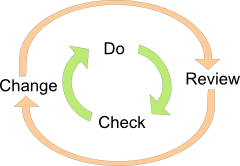
To stop standards becoming a bureaucratic monster, spend at least 10% of standards effort on reviewing and changing the standards themselves.
I like standards. I like standards for processes, like ITIL. I like standards for outcomes, like system quality management.
I like standards because they make life easier. They provide guidance for unfamiliar situations. They provide a pattern of good practice that can be easily adopted. They are a great tool for improving overall capability.
Standards work by prescribing how the work should be done, often setting criteria against which work should be checked.

For standards to work, the organisation has to commit to this control cycle. Management must enforce the standards or the standards will wither away.
There is a danger, though, that in our enthusiasm to follow the standards, we let them become our masters. They turn from being a valuable tool of management, to a bureaucratic monster that has to be constantly fed with time and management attention, but gives little back in return.
To avoid this, you need two loops.

As well as committing to a process of following the standards, you have to commit to a process of reviewing and changing standards.
This outer process is not just there to make standards more rigorous, but to make the standards more valuable, more efficient, and more accepted. You should:
The second loop moves standards from being solely a quality assurance and control activity, to being a vehicle for setting direction and organisational learning.
When you are reviewing and changing standards, focus on difficulties, even if this means ignoring the enthusiasts.
The aim of the review process is to understand what's really going on, and to fight both indifference and bureaucracy, not to reassert the purity and rigour of the standards.
Reviewing and changing standards is critical. The time and money you spent on writing or buying in standards will soon be lost unless you make sure the standards stay relevant and accepted in the organisation. You must build the review of the standards into the standards processes themselves.
Reviewing standards takes time and management attention. As a rough guide, if you add up all the time you spend on standardisation (promoting and enforcing the standards, and using them to check work), then reviewing and changing the standards should be at least 10% of this time. Spending this time on a second control loop for the standards themselves can stop the standards withering, and prevent them growing into a bureaucratic monster.